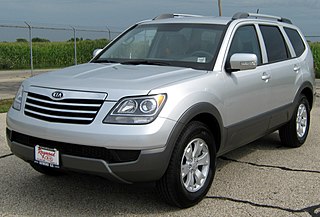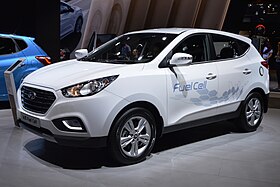
Hyundai Motor Company, often abbreviated to Hyundai Motors and commonly known as Hyundai, is a South Korean multinational automotive manufacturer headquartered in Seoul, South Korea, and founded in 1967. Currently, the company owns 33.88 percent of Kia Corporation, and also fully owns two marques including its luxury cars subsidiary, Genesis Motor, and an electric vehicle sub-brand, Ioniq. Those three brands altogether comprise the Hyundai Motor Group.
A hydrogen vehicle is a vehicle that uses hydrogen fuel for motive power. Hydrogen vehicles include hydrogen-fueled space rockets, as well as ships and aircraft. Power is generated by converting the chemical energy of hydrogen to mechanical energy, either by reacting hydrogen with oxygen in a fuel cell to power electric motors or, less commonly, by burning hydrogen in an internal combustion engine.

The Hyundai Tucson is a compact crossover SUV produced by the South Korean manufacturer Hyundai since 2004. In the brand's lineup, the Tucson is positioned below the Santa Fe, and above the Kona and Creta. It is named after the city of Tucson, Arizona. The second-generation model has been marketed as the Hyundai ix35 in several markets, including Europe, Australia and China, before reverting to Tucson for the third-generation.

A fuel cell vehicle (FCV) or fuel cell electric vehicle (FCEV) is an electric vehicle that uses a fuel cell, sometimes in combination with a small battery or supercapacitor, to power its onboard electric motor. Fuel cells in vehicles generate electricity generally using oxygen from the air and compressed hydrogen. Most fuel cell vehicles are classified as zero-emissions vehicles that emit only water and heat. As compared with internal combustion vehicles, hydrogen vehicles centralize pollutants at the site of the hydrogen production, where hydrogen is typically derived from reformed natural gas. Transporting and storing hydrogen may also create pollutants.

The Honda Clarity is a nameplate used by Honda on alternative fuel vehicles. It was initially used only on hydrogen fuel-cell electric vehicles such as the 2008 Honda FCX Clarity, but in 2017 the nameplate was expanded to include the battery-electric Honda Clarity Electric and the plug-in hybrid electric Honda Clarity Plug-in Hybrid, in addition to the next generation Honda Clarity Fuel Cell. Clarity production ended in August 2021 with US leases for the fuel cell variant continuing through to 2022.
Hydrogen technologies are technologies that relate to the production and use of hydrogen as a part hydrogen economy. Hydrogen technologies are applicable for many uses.

The Chevrolet Sequel is a purpose-built hydrogen fuel cell-powered concept car and sport utility vehicle from Chevrolet, employing the then latest generation of General Motors' fuel cell technology.

An alternative fuel vehicle is a motor vehicle that runs on alternative fuel rather than traditional petroleum fuels. The term also refers to any technology powering an engine that does not solely involve petroleum. Because of a combination of factors, such as environmental concerns, high oil-prices and the potential for peak oil, development of cleaner alternative fuels and advanced power systems for vehicles has become a high priority for many governments and vehicle manufacturers around the world.

The Toyota FCHV is a current hybrid hydrogen fuel cell vehicle development programme of the Toyota Motor Corporation, which was leased to a limited number of drivers in the United States and Japan beginning in 2002. "FCHV" stands for "Fuel Cell Hybrid Vehicle". A number of prototypes have been produced, up to the latest FCHV-adv ("advanced").

The Kia Mohave, marketed in North America and China as the Kia Borrego, is a sport utility vehicle (SUV) manufactured by the South Korean manufacturer Kia. The vehicle debuted in 2008 in the Korean and U.S. markets. The Kia Borrego is named after the Anza-Borrego Desert State Park in California; Borrego means "bighorned sheep" which can be found in the state park.

A fuel cell bus is a bus that uses a hydrogen fuel cell as its power source for electrically driven wheels, sometimes augmented in a hybrid fashion with batteries or a supercapacitor. The only emission from the bus is water. Several cities around the world have trialled and tested fuel cell buses, with over 5,600 buses in use worldwide, the majority of which are in China.

The Mazda Premacy Hydrogen RE Hybrid or Mazda5 Hydrogen RE Hybrid was a hydrogen powered hybrid car produced by Mazda. Later models were also called the Mazda Hydrogen RE Plug in Hybrid. The first car was unveiled in 2005, with an improved version shown at the 2007 Tokyo Motor Show. Mazda planned for the car to enter production and leased a few cars to end users in 2009 in 2010.

The Toyota Mirai is a mid-size hydrogen fuel cell vehicle (FCV) manufactured by Toyota, and is one of the first FCV automobiles to be mass-produced and sold commercially. The Mirai was unveiled at the November 2014 Los Angeles Auto Show. As of December 2021, global sales totaled 17,940 units; the top-selling markets were the U.S. with 9,274 units, Japan with 6,618 and the rest of the world with 2,048.

The Hyundai Intrado is a mini SUV concept car made by Korean company Hyundai. It is powered by a hydrogen fuel cell powertrain with a 36-kWH Lithium-ion battery. It has a range of about 370 mi (600 km) on a single fill up.

The Hyundai Nexo is a hydrogen fuel cell powered crossover SUV that was revealed at the 2018 Consumer Electronics Show on January 8, 2018. Replacing the Hyundai Tucson FCEV, the Nexo is the flagship for Hyundai's "eco car" portfolio.

The Hyundai ix35 is a compact crossover SUV produced by Beijing Hyundai while the predecessing Hyundai Tucson was sold in China alongside as a cheaper alternative next to the Hyundai ix35. The ix35 name was introduced by Hyundai in 2009 with the launch of the second generation Tucson crossover, but only outside South Korea and North America. From 2015, with the introduction of the third generation model, the model was again sold as the Tucson. In China, Beijing Hyundai kept the ix35 as an independent model, due to its high demand. As a result, the Tucson and ix35 crossovers were sold alongside in the same market.
The Wright GB Kite is a range of full-size zero-emission single-deck buses manufactured by Wrightbus since 2022. Similar in body style to the diesel powered Wright GB Hawk, the GB Kite is an integral design that can be built as a battery electric vehicle, the Electroliner BEV, and as a fuel cell electric vehicle, the Hydroliner FCEV.

The Hyundai N Vision 74 is a concept car developed by Hyundai. The sporty car was unveiled at N Day 2022, an event organized by the Hyundai N performance division in mid-July 2022 at Busan, South Korea, alongside the Hyundai RN22e concept based on the Hyundai Ioniq 6 electric vehicle. The N Vision 74 is a rear-wheel-drive coupe driven by two electric traction motors, both on the rear axle; power is provided by both a storage battery and a hydrogen fuel cell.

The Hyundai Vision FK is a concept car that uses a plug-in hybrid drivetrain with both a large traction battery and a hydrogen fuel cell; the concept vehicle was developed by Hyundai and Rimac Automobili. The mid-motor, rear-wheel-drive sports coupe was unveiled at the Hydrogen Wave Forum in September 2021, an event organized by Hyundai to outline its plans to popularize hydrogen vehicles by 2040 for "Everyone, Everything and Everywhere". Power is delivered through two electric traction motors, both on the rear axle. The Vision FK can be plugged in to recharge its traction battery, which has more than 60 kW-hr of energy storage capacity, and the onboard fuel cell affords it a range greater than 600 km (370 mi).


















